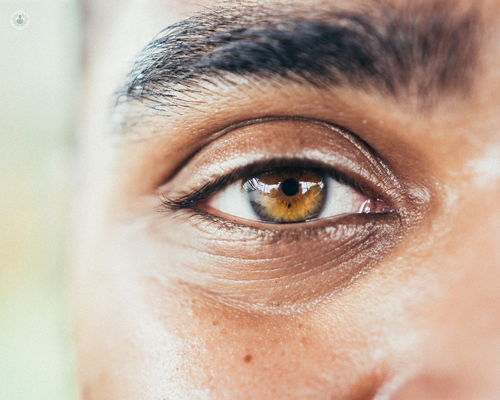What is a LipiFlow® procedure?
Written by:LipiFlow® is a treatment device designed to apply heat to the meibmomian glands to relieve dry eyes. This heat therapy helps to melt the contents of the gland to relieve blockages and allow a better flow of lipid around the eye. We asked ophthalmologist, Mr Myer Yodaiken to explain this procedure in a little more detail.

Who needs this treatment?
This is specifically design to unblock the meibmomian glands for people with dry eye disease. This disease is becoming increasingly common and this procedure helps relieve symptoms.
It’s also useful for people who suffer from blepharitis – a condition which causes red, swollen and itchy eyelids.
What does the LipiFlow® procedure involve?
There is an eyepiece called the LipiFlow® Activator which is placed under the upper and lower eyelid. The eyepiece is shaped so that contact with the cornea is prevented.
The eye piece is fitted and then all you need to do is lie down on the treatment chair and wait approximately 12 minutes.
The treatment applies continuous and controlled heat to the inner surface of the eyelid, but at the same time, protecting the eye with an insulated shield. Applying pressure also enables the obstructed gland to release secretion and improve the lipid layer.
In a clinical study, around 32 per cent of patients reported no discomfort and 48 per cent of patients said they were aware of some pressure but didn’t experience any pain.
Are home therapies as effective?
Heat therapies used at home, such as hot flannels, heated bean bags, dry bags etcetera, can reduce symptoms, but have their limitations:
- They don’t maintain their temperature and cool down too quickly to have a proper effect.
- The heat can only be applied to the outer eyelid, thus isn’t targeting the correct area where the glands are.
- The eyelid tissue itself has insulating properties which reduces the effect.
Is LipiFlow® safe?
Yes, LipiFlow® is safe. It’s a non-invasive procedure and would be safe even in normal patients.
How long does LipiFlow® last?
LipiFlow® treatment can last a long time. Some patients have lasting relief from just one treatment, however most patients, especially those who have a chronic disease, may need a top up treatment to boost the initial treatment.
The evaluation and decision to retreat takes place after one year. Not all patients need treatment but many do.
How do results from LipiFlow® compare to similar blepharitis treatments?
In my opinion, this procedure is better than similar treatments. Heat therapy can help to melt the contents of the gland to alleviate the blockage and allow a better flow of lipid to be produced.
Many of you may have tried some of the heat therapies available for home use, for example hot flannels, eye bags, heated bean bags, etc. These certainly can be of help but like I previously mentioned, there are limitations to their effectiveness. Fortunately now, with the development of LipiFlow®, these limitations have been addressed.
If you feel like you need this treatment or would like to discuss with a specialist, visit Mr Myer Yodaiken’s profile and book an appointment with him online.


